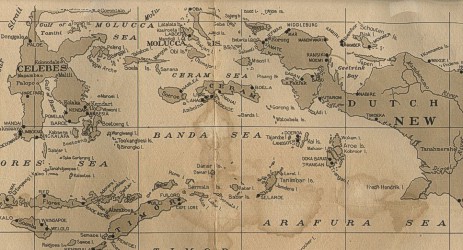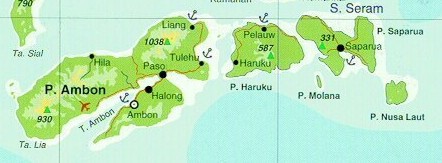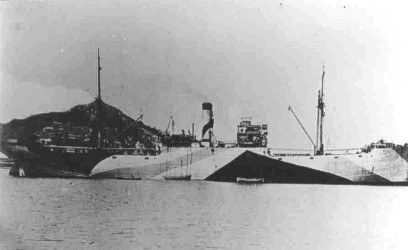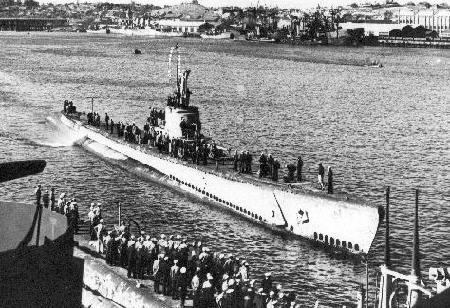|
Death in the Spice Islands |
|||||||||
|
Compiled by Amanda Johnston |
|||||||||
|
|
|||||||||
|
From Java to an Uncertain Fate One of the major tragedies amongst the horrific stories of the Far East prisoners of war in Japanese hands during the Second World War is that of the drafts from Java to the Molucca Archipelago or ‘Spice Islands'. My father, Flight Sergeant Eric ``Johnny" Johnston, was in one of these parties – a large group whose destination was the tiny island of Haruku (Haroekoe) just east of Ambon and it is this draft that is described in the following. Such was the cruelty and sadistic mind set of the Japanese responsible for this expedition that it is reckoned only about one-third returned to Java, but how many ultimately survived the deprivations, cruelties and dangerous sea journeys still to be endured following this draft, to once more see the shores of their native lands, it is difficult to judge. The description I give here is that of the Haruku draft, which was assembled in April 1943 when a parade was formed at Jaarmarkt Camp in Sourabaya, Java and 2,070 so-called ‘fit' men, i.e. those who were not lame or seriously ill at that stage, were chosen to board ships to what was at that stage an unknown destination. Selection was carried out on the basis of a glass rod being inserted in the rectum to check for the presence of blood and thereby dysentery. No subsequent examination was made of these samples, so it was essentially a pointless but degrading exercise.
To Hell on the Hellships The band of 2,070 men forming C Group, consisting mainly of RAF and a smaller Dutch contingent was then herded on to the Amagi Maru and the Matsukawa Maru where they had to endure appalling cramped and filthy conditions with limited food and water on the two-week voyage. The group included dysentery carriers and the severe over-crowding in the ships was causing this to spread fast.
Haruku is known as the "nutmeg island" of the "Spice" group but to the shattered and dispirited men who were to be its temporary guests it might as well have been the bowels of Hell.
White Coolies They were to be deployed as slave labour – these men in the bloom of their youth, many of them highly-trained and skilled in technical applications – air crew, fitters and armourers, aircraft engineers and radio operators. My father, for example, had undertaken three years training at RAF Halton and RAF Cosford as a Fitter/Armourer where he had passed out top of the entry, only to spend at least as long again wielding primitive tools for the Japanese war effort. Their task was to be the building of an airstrip – a potential Japanese launch pad to Australia, but unfortunately a hump of coral graced the surface of the island and had to be hacked away by hand to make the land level, using a native hand tool called a pachul, or pickaxe, and a chisel. Added to the parlous state of health due to months of starvation, which led to serious conditions such as beriberi, pellagra, malaria caused by mosquitoes and the scourge of dysentery that was to run like wildfire through the temporary population of this island, there were now the diabolical tropical ulcers which could be caused by a small scratch from a piece of flying coral or the casual blow of a guard's rotan (bamboo pole) and which could fester to huge proportions, as well as the blinding sun to contend with as it reflected mercilessly off the pale coral that the men were forced to excavate. Over the next few months, dysentery was to claim 1 in 5 of those POWs who were taken to Haruku, as over the weeks a total of almost 400 men were carried with decreasing ceremony to ‘Boot Hill' on the shores of that would-be paradise island, there to be laid to final rest close to the sandy shores. The nauseating stench of death permeated the whole camp and its environs. This poem, the authorship of which it has unfortunately not been possible to trace, gives an evocative and graphic picture of the grim and hopeless nature of their incarceration: Across the Way There they lie in four rows deep Upon Haroekoe's shore Imperial palms watch o'er death's sleep Like guardians evermore
Their battle ground a bamboo bed The foe, disease and death In no-man's land the living dead Fought grim to the last breath
Four hundred heroes of old England Deep in the sandy soil One fifth of that two thousand Sent there to sweat and toil
Within a week of landing there From hell thro' which they came The camp was a chaos rare The prisoners the same
Dysentery had smote them hard In stomachs long unfed All medicines to them were barred They had to die instead
Twelve hundred soon in torment lay Packed tightly side by side A bowl of rice three times a day All else to them denied
Thro' many a long day they fought Against destiny's strong hand And those who sanctuary sought Rest now beneath the sand
Some were ghastly spectacles Contorted, lame and blind And stout were the hundred medicals To whom they were assigned
In vain they fought a losing game Tenacious and with skill But as more fierce the fight became The graves spread up the hill
The enemy, the "invincible" In might's abysmal gloom Struck down with indifference To death's ethereal tomb
They groaned, they wreathed away the time Life drained from them in blood and slime Not by explosives slain
Some saw the end approaching swift Darkened with certainty They prayed for the immortal gift Peaceful eternity
Others in British tradition Fought bravely to the end The valorous 'Killed in Action" Our honour to defend
So now four hundred crosses All raggedly aligned Mark out the terrible losses The battle left behind
No medals ever will be worn By those across the way But the thoughts of those behind Are with them night and day
The Evil Gunso Mori Perhaps the most pernicious threat to the survival of the prisoners was the presence of the Japanese guard, Gunso (Sergeant) Mori and his sycophantic Korean sidekick and interpreter, Kasiyama. Known as ‘Blood and Slime' respectively (two of the symptoms of dysentery), all power seemed to have been devolved to Mori by the laissez-faire camp commander, Lieutenant Kurishima. Mori's use of violence was purely gratuitous and indiscriminate. Ranks, NCOs, doctors and officers – none were safe from the wrath of his rotan. Squadron Leader Pitts, the Senior British Officer on Haruku particularly suffered at his hands and yet, Squadron Leader Pitts had this to say about him after the War: ``…being in part an untamed and brutal savage and, in a much lesser degree, a placid harmless human being, possessing a strong personality and intelligence…" ``It must be said that first and last he is a soldier with some fine but indefinable quality, perhaps the absence of meanness, which, suppressed though it was, won for him a certain admiration which was not accorded to any other Japanese…it is difficult to appreciate how one man can indulge in such bestial and brutal savagery upon another, and still be regarded with a certain amount of esteem, yet such a state did indeed exist." Perhaps it was this juxtaposition of qualities that led the eminent ex-Java POW, Laurens van der Post, to base his Gunso Hara upon him in his book, ``The Seed and the Sower" which was later made into the film (under Japanese direction and therefore heavily ‘fictionised' and romanticised), ``Merry Christmas Mr. Lawrence". A book and film which, needless to say, and with the utmost justification, are heartily condemned by those POWs who experienced the real events therein. To return to the real Mori; he was directly responsible for the dysentery epidemic and the huge number of deaths because of his refusal to allow a latrine to be built over the sea for fear that it would ‘sully the ocean belonging to His Imperial Emperor'. Instead, the ground fomented with infected excreta and disease-spreading maggots and flies which overran into the rudimentary atap accommodation huts. There were certain theories about the causes behind Mori's state of mind and his brutal behaviour, including the rumour that he was an ex-China veteran who had contracted syphilis during the rape and conquest of that country and which had rendered him insane. Whatever the cause, the fact remains that he was a merciless mass murderer who paid for his crimes in the hangman's noose in Singapore in 1946.
Heroes of Haruku There were many heroes in the Pelauw camp in Haruku whose day-to-day acts of brotherhood and compassion surely alleviated the suffering of their friends under these diabolical circumstances. The doctors, amongst them Dr. Buning, Dr. Springer, Dr. Philps and Dr. Bryan, saved many lives using the crudest of contrived instruments and effecting what cures they could in the absence of medicines or even vegetation to concoct alternative means of healing. One of these heroes was not a doctor, but a botanist by training who went on to become a Professor of Botany at London University some years after the War (now an Emeritus Professor), and who was serving as a radio officer in the RAF when taken prisoner: Leslie Audus used his skills to manufacture yeast from ‘next to nothing', providing the very sick, and eventually all the men, with a source of vitamin B, the absence of which in their scant diet was worsening their state of malnutrition and causing beriberi and pellagra as well as optic neurosis, the result of which could be irreversible blindness. A good summary of his cultivation methods can be found in Dr. Richard Philps' book, ``Prisoner Doctor" as well as in his own definitive work on the Moluccas drafts – ``Spice Island Slaves". Without a doubt he saved many lives and the eyesight of many of the men by developing his cultures, and they were most fortunate indeed that he was in the Haruku draft where conditions were so appalling. He was only permitted to continue with his yeast-making activities because one of the by-products was alcohol, which was then commandeered by the Japanese guards.
Departures from Haruku
Even by the end of 1943, US operations were intensifying over the Ambon area, notching up the casualty list of POWs and indigenous peoples as well as the Japanese. Starvation, beatings and despair continued in the prison camps but despite everything the men retained a strong sense of discipline and camaraderie – the cornerstones of morale and, ultimately, of survival in such diabolical circumstances. On 1st August 1944, the gates of the Pelauw camp on Haruku were shut for the last time as the final party were moved to Ambon. The airstrip with its inbuilt ``design faults" effected by covert POW-devised sabotage – that site of such indescribable human suffering - was never really used by the Japanese who had not reckoned on the Americans out-flanking them in the Banda Sea. Between August and September 1944, most groups were clustered around Ambon, for want of sufficient means of transportation back to Java, pending their participation in the risky and piecemeal evacuation and doing their utmost to evade the heavy bombing being carried out by the US. The horror of the ``hell ships" travelling to the Moluccas has already been briefly described but in no way matches the squalor and severely over-crowded conditions of those that returned the men to Java. At that stage there were two further threatening factors – their severely weakened state of health from long-term deprivation under the dreadful conditions on the islands; and the increased US domination of the sky and sea. The infamous Maros Maru which took 70 days to reach Java from Ambon and on which 372 of the 500 men aboard perished from disease, starvation and exhaustion, has been described in detail elsewhere and so I will not do re-iterate the account here, but it was, indeed, an extreme example of the conditions that had to be endured by all those returnees who had survived the ordeal of the Spice Islands. It is nothing short of a miracle that many returned once more to Java and it is no wonder that some of those who still survive today are convinced that they had a ``guardian angel".
Postscript As a result of the terrible unrest that has troubled Indonesia in recent years, and which has become particularly bloody in the last few, it is now inadvisable to visit parts of Maluku (as the Molucca Archipelago is now known). A search on the Internet reveals details of the bloodshed from news services such as CNN and Reuters, including reports of massacres in Pelauw village in Haruku in 1999 (the site of the POW camp) during the brutal battles ensuing between Christians and Muslims. Such incidents have also badly affected Ambon and elsewhere. This is a sorry state of affairs when considered in the light of those villagers with whom the POWs were remotely in contact during those terrible months of 1942 and 1943. Many of them lost their lives in bombing raids falling shy of Ambon town, not to mention those who were executed by the Japanese for smuggling food to the POWs and other perceived ‘misdemeanours'. For the generations succeeding them to be experiencing civil war, where once there was a brutal force of occupation, is a bitter irony indeed. Despite the current turbulent struggles that surround it, the war cemetery at Ambon - to which all POWs and other allied dead from all parts of the Province were removed, including the 415 from Haruku - appears from photographs to be a beautifully tended and maintained haven and a fitting final resting place for the brave and unfortunate men who gave their lives in such appalling circumstances. Book References: The titles below are all accounts of (or contain accounts of) the Haruku draft. The definitive and most comprehensive work - ``Spice Island Slaves" also contains detailed accounts of the other Moluccas drafts and ``The Knights of Bushido" contains a sizeable passage on Haruku but is essentially a study of Japanese war crimes across many theatres.
``Spice Island Slaves" – Leslie J. Audus * ``Prisoner Doctor" – Dr. Richard Philps ``The Knights of Bushido" – Lord Russell of Liverpool ``My Life with the Samurai" – Anthony Cowling ``The Emperor's Guest" – Don Peacock ``Their Last Tenko" – ``James Home ``Old Map of Australian Airfields" - Miltary Airfields - Web Site * A third re-print of Spice Island Slaves is currently under way by kind permission of Professor Audus. Please contact Amanda Johnston at the e-mail address below to place an order.For more information about Haruku or related areas, please contact Amanda Johnston on amanda@dcode.demon.co.uk |
|||||||||
|
|
|||||||||||
|
|
|||||||||||
|
|
|||||||||||
|
|
|||||||||||
|
Best Viewed with:
|
|||||||||||
|
Design by Ron Taylor |
|||||||||||
|
Copyright © RJT Internet Services 1999 |






